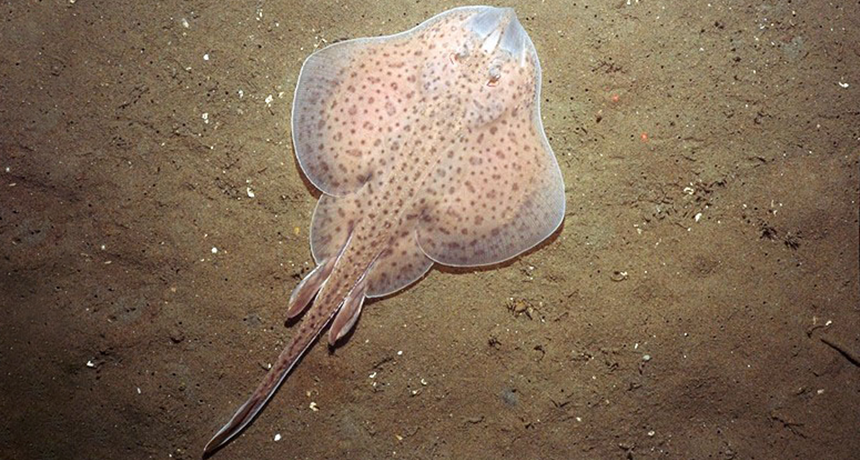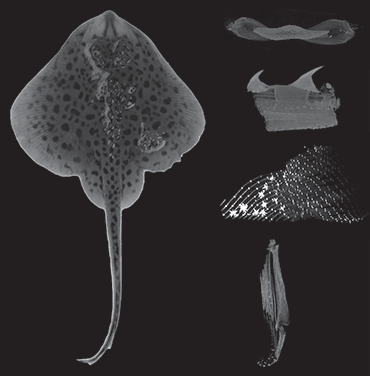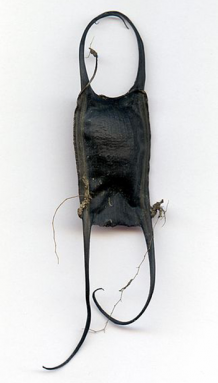Ocean acidification may ground swimming skates
In warmer and more acidic seas, little skates develop stronger jaws but weaker fins

This is a little skate, a fish closely related to sharks and rays. As the oceans get more acidic, little skates may become better walkers.
Page Valentine/USGS; adapted by L. Steenblik Hwang
The more carbon dioxide people pump into Earth’s atmosphere, warming the planet, the more carbon dioxide and heat slip into the oceans. Warmer and more acidic water is thinning the shells of oysters. But they aren’t the only ocean dwellers facing unwanted home renovations. Anything with a shell is at risk. So, too, may be certain fish. A new study finds that as seawater becomes more acidic, the skeleton of a fish called the little skate stiffens in some places — and gets bendier in others. That could leave this fish better built for walking than swimming.
Burning fossil fuels, such as oil and coal, releases carbon dioxide, or CO2. In the air, this and other greenhouse gases act like a sweater, trapping heat and raising near-surface temperatures around the globe.
The oceans also absorb CO2. And there it combines with a molecule known as calcium carbonate. This produces a new molecule, bicarbonate. The reaction leaves calcium and hydrogen atoms stranded. Those free hydrogen atoms act as an acid to lower the ocean’s pH.
This ocean acidification strongly affects organisms that make shells from calcium carbonate, such as oysters and lobsters. Fish have a built-in system for dealing with changes in ocean pH. Vertebrates — animals with backbones — tend to keep their blood’s pH levels under strict control, says Sean Bignami. He’s a marine biologist at Concordia University in Irvine, Calif. These animals, he notes, “can’t survive with a lot of variation [in blood pH].” To prevent their blood pH from changing, fish have to be pH micromanagers.
If a fish’s blood gets too acidic, it extracts a molecule, calcium phosphate, from its food. (This is a calcium atom attached to a phosphate group: a phosphorus atom and four oxygen atoms.) The phosphate is alkaline. And this tends to neutralize the pH of the fish’s blood. Fish are so good at this that they can adjust to acidic waters in only a few hours.
Skating by?

Valentina Di Santo is a physiologist — someone who studies how living organisms function. She works at Harvard University in Cambridge, Mass. Many physiologists had assumed that fish could easily deal with warmer, more acidic waters. But she was not sure. So she launched studies using little skates.
Closely related to rays and sharks, skates are shaped like round, flat discs with pointy tails. (“They are so sweet!” Di Santo says — “very social. And they get used to you and like to get tickled.”)
Little skates grow to about 50 centimeters (20 inches). Like sharks, they don’t actually have bones. Instead, their skeletons are made of cartilage, like the strong connective tissue in your nose. This cartilage is surrounded by an outer layer of tiny, calcium-filled tiles called tesserae (TESS-er-ay).
Di Santo wanted to examine the calcium in these tesserae. She used a scanning technique called computerized tomography, or CT. Tesserae stand out nicely on the CT scans. This allowed De Santo to see how they changed over time.
Little skates lay flat, rectangular eggs in a leathery covering, sometimes called a “mermaid’s purse.” Di Santo gathered 40 eggs and exposed some to normal seawater. Others got warmer and more acidic ocean water — what scientists predict the seas may be like by 2100 if people keep pumping CO2 into the air. The whole time, Di Santo scanned them regularly with a CT scanner. Their leathery coverings allowed her to keep an eye on the skates’ skeletons as they developed.
Skinny skates, higher stakes
Skates from eggs that grew and hatched in warmer, more acidic waters became wider and flatter adults than did hatchlings raised in normal water. The jaws of skates raised in the more acidified water became tougher, with more hardened tesserae. Their wings, though, were more flexible. Di Santo published her findings January 9 in Proceedings of the Royal Society B.

A flatter skate is not a better skate. “They’re skinny,” and that’s bad, Di Santo notes. What’s more, she adds, “They need to eat more at high temperatures.” And extra snacking comes with a potential cost. “Eating more means exploring the environment more often and being more exposed to [predators].”
The skate’s new skeletons might also change how they behave, she suspects. Little skates use parts of their jaws to “walk” along the seafloor. A stiffer jaw with more calcium could make them better hikers. And a heavier skeleton with more calcium could also keep them on the seafloor more often, she notes, because it would take more energy to lift off.
And skates raised in warm, acidic water might have to use more energy to keep their extra-bendy wings stiff as they swam. Di Santo worries that this extra effort might mean that skates “aren’t likely to fare well in future conditions.”
Past studies had looked at how ocean acidification might affect skeletal features in fish with bones, Bignami notes, and “didn’t find much.” But the CT scans Di Santo used gave her much more information than the methods used in those other studies.
The effects she saw, such as a slightly harder jaws and softer fins, are small, Bigmani admits. But “those can end up being pretty meaningful when you pile small effects on each other.” Together with fishing, habitat loss or other stressors, the ocean’s pH changes might break a skate.







